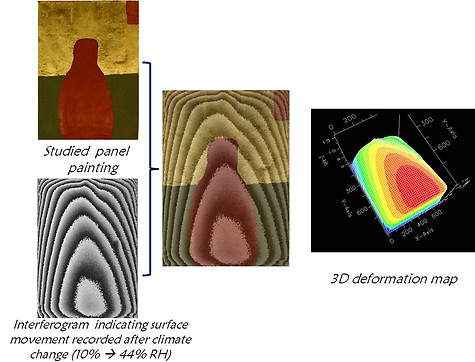

Structural Diagnostics
Over time CH materials and structures deteriorate in response to environmental factors. Detecting changes and monitoring degradation is critical in order to improve and upgrade preventive conservation strategies. Nowadays, coherent metrology and especially full-field holographic interferometry are increasingly being applied as diagnostic tools, as they are able to acquire important information for the structural condition implementing remote non-contact procedures and minimum requirements in infrastructure and field conditions. Full-field techniques (and as such we consider any technique that may give information for the whole field of the object at once) operate at laser power densities in the safe range of a few µW /mm2 and thus may be applied unconditionally for the non-invasive and non-destructive structural examination of fragile CH objects. Full surface illumination allows measuring the volume relative displacement due to any concerned impact. Without interaction or any contact with the artwork’s surface one can remotely inspect fast and repeatedly field phenomena over the whole extent of surface or whole areas of interest. It is being used for in-situ monitoring in restoration field, providing direct assessment of structural integrity for movable artworks with multilayered surfaces (i.e. paintings, icons), objects (i.e. statuettes) as well as for immovable structures such as statues or monuments (i.e. wall paintings). Ageing, previous restoration procedures, accidents are among the features that can be revealed through Holographic Interferometry diagnosis on the basis of study of the distribution of interference phenomena forming fringe patterns.


Far-field studies on the structural condition of a wall painting at the 16thC castle in Brezice, Slovenia
Structural condition assessment -Wallpaintings
Wall paintings in buildings and monuments of historical interest interact with the environment and deteriorate day after day. DHSPI provides accurate deterioration maps where potentially problematic areas can be localized. Instead of using contact-methods or “knocking” to detect voids, this non-contact technique offers more accurate and immediate information, giving a detailed map with all possible detachments as well as an estimation of the magnitude of surface movement. Detachments created underneath the painting surface may expand in x-y directions but they actually detach the painted surface in the z-direction.

Monitoring of environmental changes on Panel paintings with wooden substrate
Panel paintings with wooden substrate and other organically composed works of art are particularly sensitive to climate and environmental changes as they are prone to constant but invisible dimensional effects in their structure. Sudden relative humidity (RH) fluctuations are of major concern within museums, churches, and during transport as they may provoke several problems in wooden panel paintings, which include warping and buckling of the structure, as well as delamination of the more brittle ground. Environmental control is a particularly important issue in CH conservation, although potentially almost impossible in the open structure of many buildings.
Wooden panel painting samples simulating byzantine icons have been constructed by conservators in the National Gallery of Athens in the scope of the “MULTIENCODE” project (SSPI – 006427). The samples have been monitored with DHSPI following a change of RH(from 10% to 44%). It was shown that DHSPI is able to monitor the micro-movement of the artwork as it adjusts to the studied environmental relative humidity changes.

Control of laser cleaning interventions
Cleaning interventions are irreversible and thus call for particular attention as regards their monitoring and control. Lasers particularly are often in dispute due to skepticism as regards potential side effects to the original surfaces (chemical modifications & photomechanical effects). In this respect Laser Coherence Metrology (LCM) offering high potential in detecting mechanical deformations, was found particularly sensitive to monitor and assess the short and long-term changes induced upon laser cleaning interventions.
